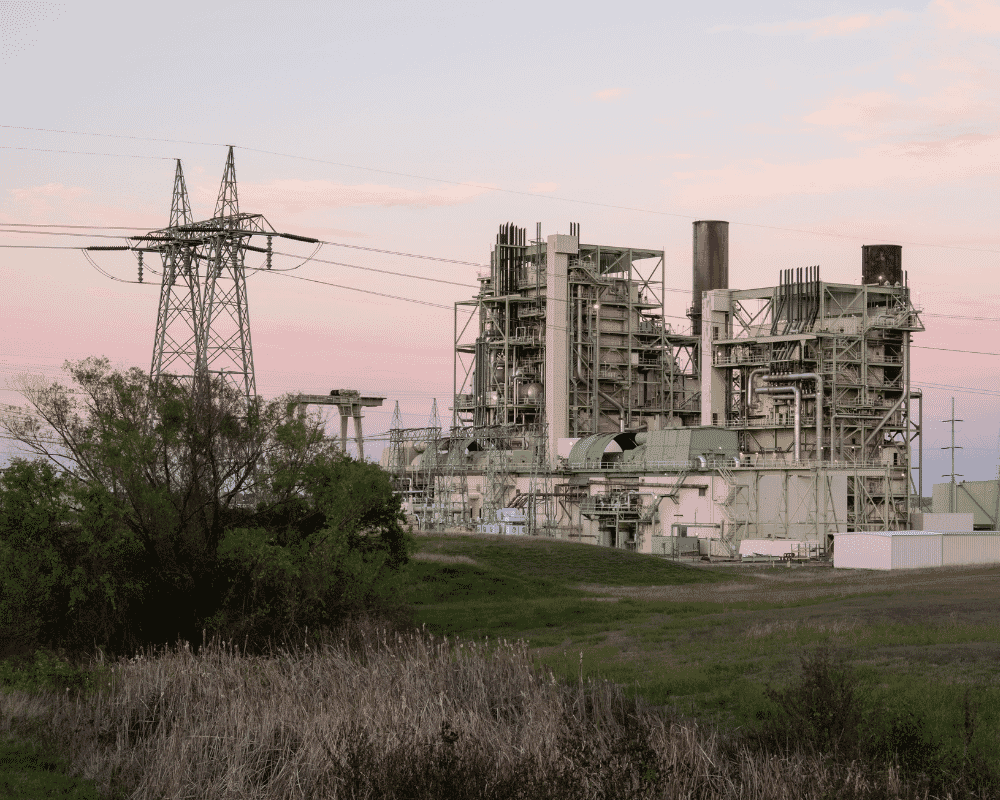
Ultimate Guide to Rotary Screw Air Compressor System Design, Part Two: Eight More Questions About Deploying a New System
March 12, 2025
The Eight Key Components of a Rotary Screw Compressor
March 26, 2025A Beginner’s Guide to Reading Rotary Screw Compressor Performance Curves
Kaishan USA | March 19, 2025| Uncategorized

New compressor data sheets will now provide even more information that facilities can use to improve their energy efficiency in applications from food and beverage to semiconductor and aeronautics.
There’s a new sheriff in town: a new way of comparing the efficiency of air compressors, not only across different sizes and types but also among the various compressor brands.
The new standards have been under consideration since 2017, and manufacturers began voluntarily publishing results after the U.S. Department of Energy finalized the rules in 2020. (The new rules are summarized in a presentation titled “Air Compressors—DOE’s Current Regulations.”)
They became effective on January 10th of this year and require that most air compressors (flow of 35 CFM-1,250 CFM and pressures of 75 PSIG-200 PSIG) meet new compressed air isentropic efficiency ratings. The new requirements are designed to save energy, reduce environmental impact and make it easier for purchasers to compare the energy efficiency of products. In fact, the new regulations will save $200 to $400 million in energy costs over the next several decades.
As a result, many government agencies and utility companies are expected to begin using the new standards to determine eligibility for rebates.

CAGI's New Compressor Data Sheet
Manufacturers are required to complete the new data compressor data sheets for the following types of equipment:
- Fixed and variable speed rotary screw air compressors (air-cooled)
- Fixed and variable speed rotary screw air compressors (water-cooled)
- Different types of compressor dryers
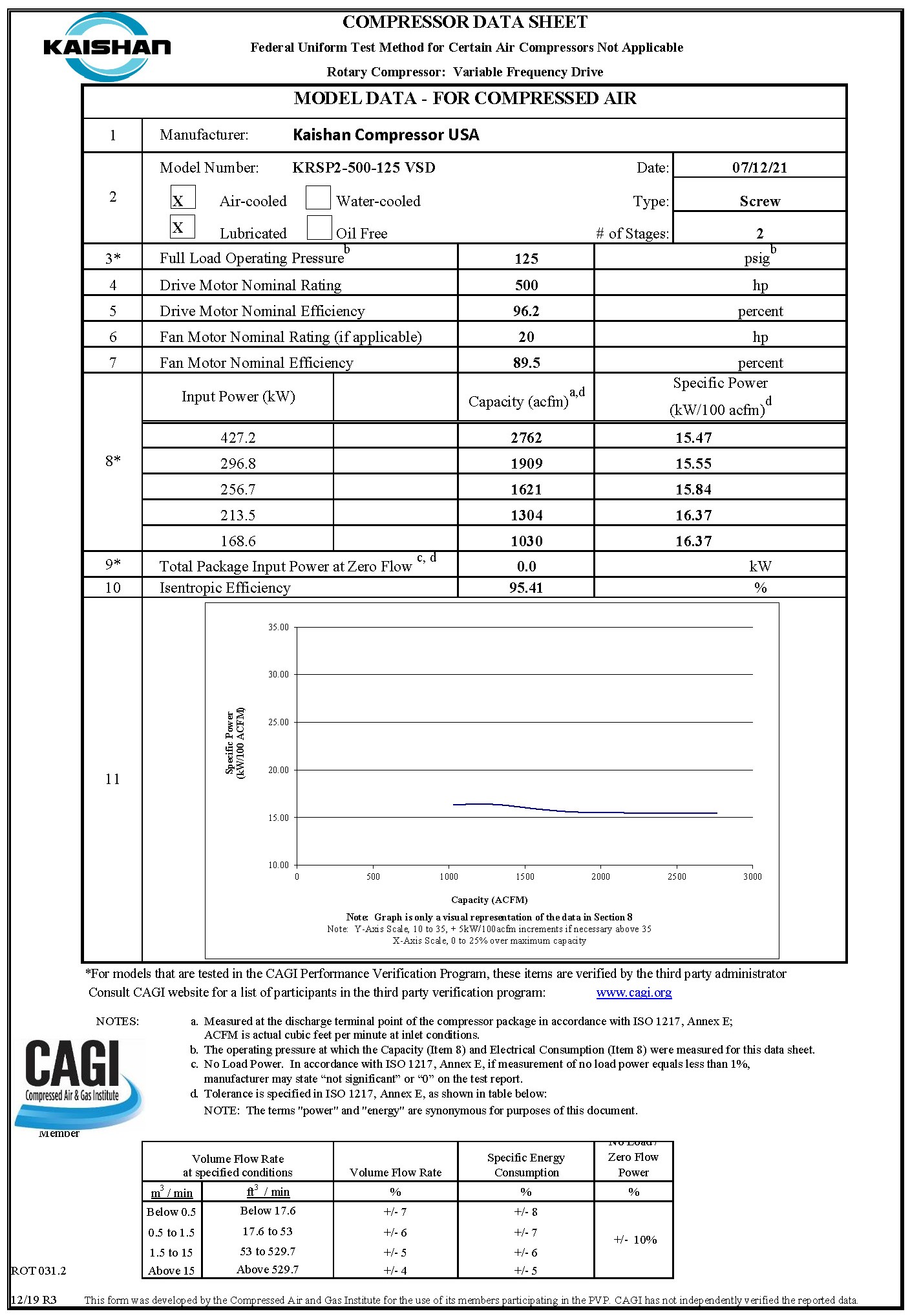
CAGI’s new compressor data sheet.
The new compressor data sheets require the manufacturer to list the following specifications for a fixed-speed compressor:
- Rated capacity at full load operating pressure
- Full load operating pressure
- Maximum full-flow operating pressure
- Drive motor nominal rating
- Drive motor nominal efficiency
- Fan motor nominal rating (if applicable)
- Fan motor nominal efficiency
- Total package input power at zero flow
- Total package input power at rated capacity and full load operating pressure
- Package specific power at rated capacity and full load operating pressure
- Isentropic efficiency
The big news is the last item, measuring the air compressor isentropic efficiency, which all manufacturers are now required to supply.
The new regulations shift the emphasis from a more established rating, specific power, which measures how much energy (in kilowatts) is needed to produce 100 ACFM of power. Specific power works well if the compressors are rated at the same load pressure. The problem is that different manufacturers use different load pressures. In addition, it may seem counterintuitive, but the machine with the lowest rating is the best.
As a result, a new measurement, isentropic efficiency, has been designed to address that problem.
What Is Isentropic Efficiency?
Isentropic efficiency compares ideal isentropic power to actual power consumed during compression. It thus measures a compressor’s ability to convert electrical energy into compressed air (potential energy). It’s roughly analogous to the U.S. Environmental Protection Agency’s ratings for cars.
It reflects the fact that compressors always use more energy than their theoretical models would indicate because of real-world factors like heat, slippage, friction and pressure losses. In effect, a compressor always uses more power than you’d expect. So, the isentropic efficiency number is expressed as a percentage: the ideal energy consumption compared to the actual energy consumed. The higher the number, the more efficient the compressor.
The goal is to create a standard measurement that compressor buyers can use to make apples-to-apples comparisons among different types of air compressors.
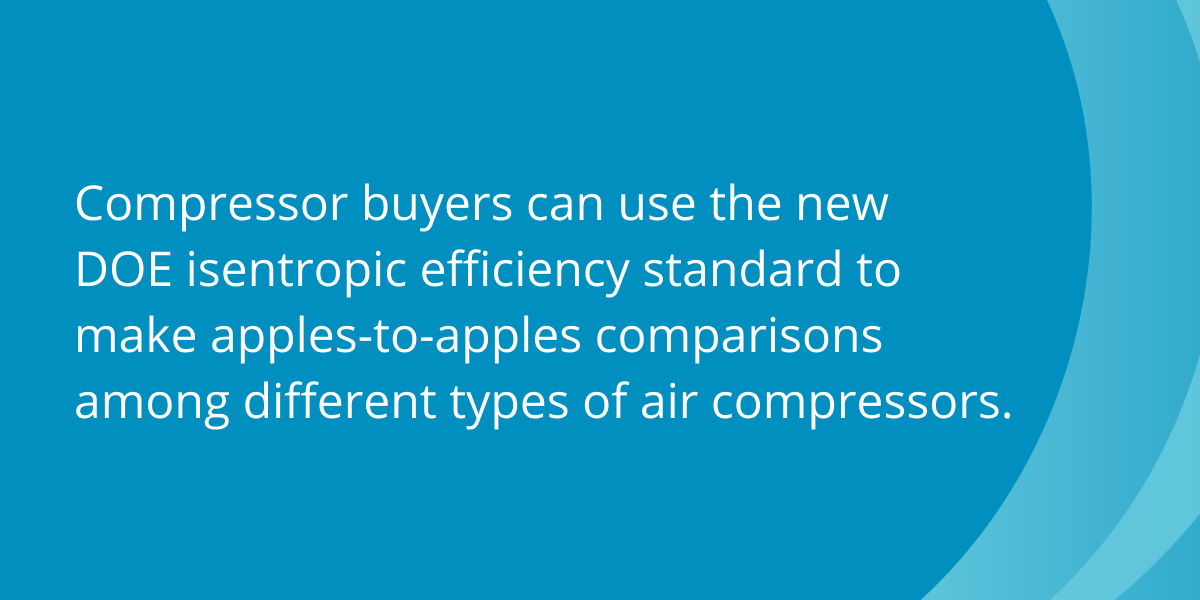
Compressor manufacturers are now required to measure the isentropic efficiency of their products so that purchasers can make apples-to-apples comparisons among different compressor types and brands.
Because air compressors are more efficient at higher capacities, manufacturers must calculate ratings for different machine sizes: the minimum standard ranges from 53% for the smallest compressors to 75% for larger units.
How Is Isentropic Efficiency Measured?
DOE requires manufacturers to develop the information using actual testing or an alternative efficiency data measurement the agency has approved.
The CAGI Performance Verification Program takes the process one step further, confirming the manufacturers’ data with third-party testing to bolster customer confidence in the results.
Fixed-speed air compressors are only rated at 100% load. However, the performance of variable-speed compressors is rated at several different data points.
Variable-Speed Drive Air Compressor Performance
The new reporting tool includes a performance chart showing how a VSD air compressor would perform at various turndown points, from maximum to minimum.

The new CAGI form also requires that manufacturers supply data showing the performance of their VSD compressors at various turndown points.
A performance curve graphically illustrates that data, plotting the specific power of a VSD compressor against its actual cubic feet per minute.
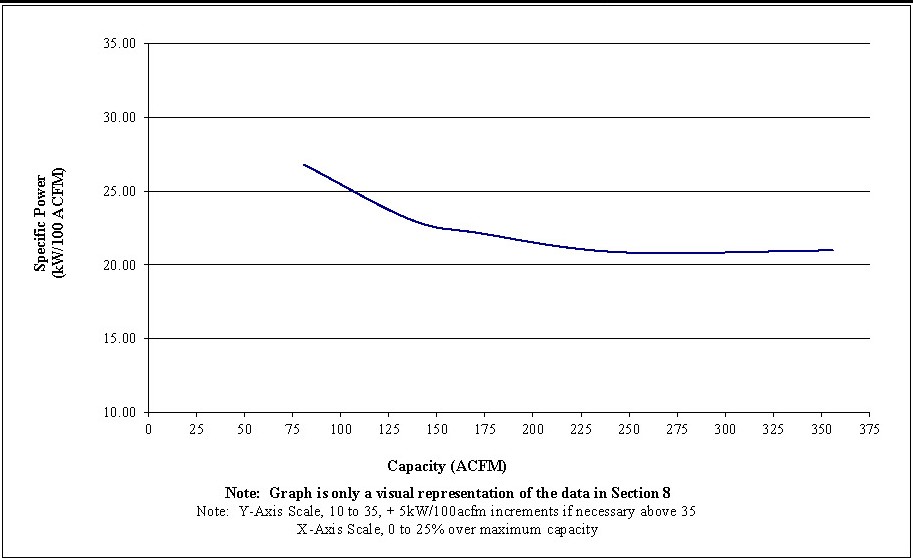
This performance curve shows how the specific power of a KRSP 75-HP, 125-PSIG VSD rotary screw air compressor changes as the flow capacity (ACFM) increases.
DOE’s final rule noted that specialty compressors created for hazardous environments may not meet the standards because of unique accommodations to withstand corrosive chemicals or extreme temperatures. As a result, some compressors customized for applications in the mining and marine industries may not qualify.

Specialty air compressors designed for hazardous environments, such as mining or marine applications, may not comply with the new isentropic-efficiency standards because they have been adapted to withstand harsh conditions.
Using Air Compressor Isentropic Efficiency
There are several ways to use this information.
1. See How a Compressor Is Equipped
The compressor data sheet shows flow and pressure measurements, the type of compressor and the number of stages. It also indicates whether the compressor is air- or water-cooled and whether there is just one fan (cooling the entire package) or two (a separate oil-cooler fan).
2. Help You Decide Whether You Need a VSD
The specific power ratings demonstrate the energy-saving sweet spot for VSD compressors. It clearly shows that the specific power is best (the lowest number) in the center of the data range. And confirms that VSDs don’t save energy at the extremes—above 80% or below 20% of capacity.
3. Compare Among Competitive Models
The new chart allows you to compare different machines for your specific applications. And even contrast identical models from various competitors. But be careful to make an apples-to-apples comparison—make sure you are looking at the same pressures, flows, cooling methods and number of stages.
In addition, most companies today find that the initial price is less than 20% of a compressor’s total cost of ownership: A U.S. Department of Energy study from 2000, placed the cost of buying and installing an air compressor at only 12% of lifetime costs, with electricity gobbling up 76% of the total cost of ownership.

According to the U.S. Department of Energy, the initial expense to acquire and install a compressor is only 12% of the lifetime cost. On the other hand, electricity makes up 76% of a compressor’s total cost of ownership.
So, you’ll want to keep these efficiency curves handy when you’re purchasing a new unit.
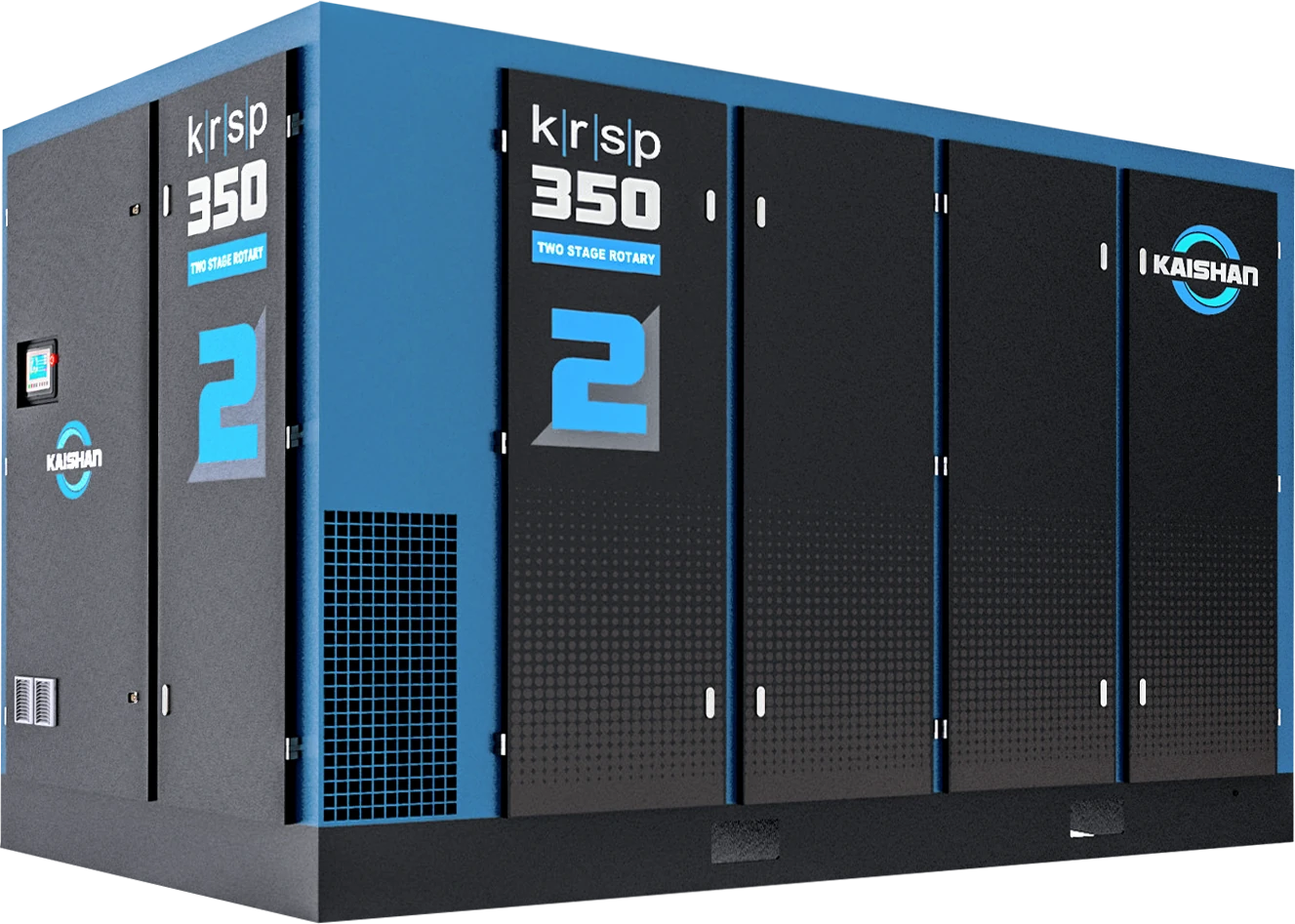
Kaishan’s KRSP2 two-stage premium rotary screw air compressor is one of the most energy-efficient machines on the market. Its 500-HP, 125-PSIG unit, for example, has an isentropic efficiency rating of 95.41% when equipped with a VSD.
Local Help in Using the New Compressor Data Sheets
If you’re unsure how to take advantage of this new information, you should probably work with a local compressed air professional to see how it can help you. We work with a nationwide network of independent distributors, who can provide on-site help and consultation as needed.
We partner with these independent, local distributors because it's the best way to serve you. Unlike large corporate suppliers, there's no red tape here; our distributors offer expert guidance, faster response times and personalized support tailored to your needs. They don't just sell compressors—they build relationships, ensuring you get the right system, reliable service and quick access to parts when needed.
With factory-trained technicians and a deep understanding of industrial applications, they help maximize efficiency and minimize downtime. So, when you buy through Kaishan, you're getting more than a product—you're getting a local partner who cares about your business and wants to see it succeed.
Key Takeaways
- There’s a new way of comparing the efficiency of air compressors, not only across different sizes and types but also among the various compressor brands.
- The DOE standards that went into effect in January require that most air compressors meet new compressed air isentropic efficiency ratings.
- The new regulations create an alternative to the more established rating, specific power.
- The new rating, isentropic efficiency, compares ideal isentropic power to actual power consumed during the compression process.
- There are several ways to use the new data, including seeing how a compressor is equipped, deciding whether you need a VSD and comparing competitive models.
Let Us Help
Using the new compressor data sheets, especially the entropic efficiency ratings, is a great way to ensure that your next air compressor purchase optimizes the energy efficiency of your compressed air system. If you need help understanding that information, get in touch with the experts at Kaishan. Contact us today.
Listen to the Podcast Version
Understanding Isentropic Efficiency Standards
Welcome back to the Big Dog podcast! As always, it's great to be with you!So, Jason, did you hear the news? There’s a new sheriff in town: a new way of comparing the efficiency of air compressors, not only across different sizes and types, but also among the various compressor brands!
That's right, Lisa! On January 10th, 2025, these new isentropic efficiency standards came into play, setting a completely new benchmark for compressors. If you’re in the industry, you’ve probably seen the term thrown around a lot lately, maybe even on some spec sheets. But what does it actually mean?
Right, and it’s not just about slapping a new term on old concepts, is it? These standards seem designed to make things clearer for buyers and, honestly, manufacturers too. They’re covering efficiency ratings that go beyond just specific power, which was the older metric people used.
Exactly. See, specific power was…well, it was okay, but it wasn’t great. The problem? Specific power measures energy consumption per hundred cubic feet per minute, but it’s only useful when you’re comparing compressors at identical pressures. And let me tell you, Lisa, most manufacturers don’t standardize those pressures.
Wait, so—hang on—if pressure varies between brands, doesn’t that make comparing compressors kind of...impossible for buyers?
Bingo. That’s exactly why they introduced isentropic efficiency. What it does is compare the actual power consumption of a compressor to the theoretical ideal power. It’s a percentage—closer to, say, the way the EPA rates cars on miles per gallon. And the higher that percentage, the more efficient the compressor is.
So in this case, you’re looking for a bigger number—higher is better, right?
Definitely. But keep in mind, real-world operation always adds some inefficiencies—heat, friction, you name it. Even the best compressors can’t hit 100%, but the DOE has set minimum efficiency thresholds: 53% for smaller compressors and up to 75% for the big ones.
Right, and that’s across a range of operating pressures—from what, 75 to 200 PSIG?
Exactly. And that range? That’s critical because one of the biggest takeaways from this shift is that you can now make apples-to-apples comparisons between brands, models, and even compressor types. It’s not like before, where you had to navigate through inconsistent specs and hope you’d land on the right one.
Okay, but what’s making this metric stand out more? Like, besides being consistent, how else does it simplify life for buyers, or even manufacturers?
Well, for buyers, it creates more transparency. Now your spec sheet doesn’t just show what the system does at full load and nothing else. With isentropic efficiency, you’re seeing how well it converts electrical energy into compressed air under realistic conditions.
And that has huge implications, like, for choosing the right machine. Because if I’m running a plant and have to make sure my long-term energy costs stay in check, these numbers are suddenly a big deal, right?
A massive deal. And yeah, part of the DOE’s whole strategy here is to reduce energy use, make compressors more efficient overall, and save buyers money over time. They estimate we’re talking $200 to $400 million in savings across the next few decades just because of these changes.
That’s huge. Honestly, I think we’ll see more buyers pushing manufacturers for better numbers now that they can actually compare with confidence.
Assessing the Total Cost of Compressor Ownership
Speaking of saving buyers money, here’s a stat that really puts things in perspective—electricity accounts for 76% of a compressor’s total cost of ownership over its lifetime, while the upfront cost of that shiny new compressor? Just 12%.Wait—76%? That’s wild. So, we’re talking the bulk of your expenses isn’t even the equipment itself but, like, the energy it takes to run it?
Exactly. And that’s why looking at efficiency ratings—like this whole isentropic efficiency thing—isn’t just a nice-to-have. It’s a must-have. You’ve gotta think beyond just the sticker price.
And that’s where these new variable-speed drives, or VSDs, come into play, right? I’ve read they can really help cut down those energy costs.
Big time. VSDs are a complete game-changer for operations where air demand varies throughout the day. Instead of running a compressor full throttle all the time, VSDs let it adjust to match what you actually need. So, you’re saving energy any time you’re not at peak demand.
But aren’t there limits? Like, I’ve heard VSDs aren’t as efficient at the extreme ends—either way too low or way too high on capacity.
That’s true. They’re most efficient in the middle range, let’s say 20% to 80% of capacity. That’s the sweet spot where you’ll see the biggest savings. And honestly, that’s where manufacturers have started focusing their efforts with these new performance ratings.
Got it. So, for plants that run steady airflow all day, a fixed-speed compressor might still make sense, but for anyone with fluctuating demand, a VSD is probably a smarter investment.
Exactly. And I saw this first-hand. A plant manager I was working with switched to a high-efficiency model with a VSD, one of these newer systems that align with these updated efficiency norms. They saved tens of thousands annually on their energy bills. Tens, Lisa.
That’s impressive. And I’m guessing they probably paid off that initial investment pretty quick with savings like that.
They did. And you know, these updated performance curves make it easier for buyers to see exactly where the value lies. It’s all about making smarter choices upfront to reduce those long-term costs.
Maximizing Resources under New Regulations
Right, and with those updated performance curves making it clearer where to save, what really stands out to me is how much these local distributors are becoming key players now. They’re not just dropping off compressors at the loading dock—they’re actually guiding facilities through all this technical stuff, like performance curves and isentropic efficiency ratings.Exactly. And, honestly, without their help, it’s a nightmare. I mean, figuring out which model fits your needs, running the numbers, making sure you’re hitting those DOE efficiency standards...that’s a full-time job.
Absolutely. I actually worked with this maintenance team—total pros when it came to running their machinery, but once the new efficiency standards came along, they were, like, overwhelmed. They had no idea where to start. The specs looked like a foreign language.
Yeah, I I can imagine. That’s where systematic education makes all the difference, huh? You teach ’em how to read these data sheets the right way, and suddenly, boom!—they’re making smarter choices.
Exactly. We broke it down—what the specs mean, how to match the ratings to their plant’s actual needs. After that? They saw a huge uptick in efficiency. Like, not just compliance for the sake of regulations but actual operational improvements.
Right, ’cause compliance isn’t just a box to check, you know? It’s a long-term game changer. Those $200 to $400 million energy savings we talked about earlier don’t happen overnight. It comes from consistent, smart choices across the board.
And it’s not just about saving money—it’s environmental, too. These new standards aim to lower energy consumption for a reason, right? We’re reducing harm, keeping the planet in mind with every kilowatt-hour we don’t waste
. Spot on. And the thing is, this all shows how much easier the process becomes when we’ve got the right tools and partners, like those local distributors. They’re the unsung heroes here, simplifying a complex transition for the rest of us.
Totally. And for anyone listening today, the takeaway is pretty simple—take the time to dig into those new compressor data sheets, work with experts in the field, and stay focused on the bigger picture. Efficiency isn’t just a number; it’s a way to future-proof your plant.
Absolutely. Efficiency saves money, it saves resources, and, most of all, it puts you ahead of the curve in the industry. And with that, I think we’ve covered everything our folks out there need to know.
Yeah, this was a solid deep dive today. Thanks for listening, and we’ll catch you next time!
Random stat or
customer quote
textXXtext
text

